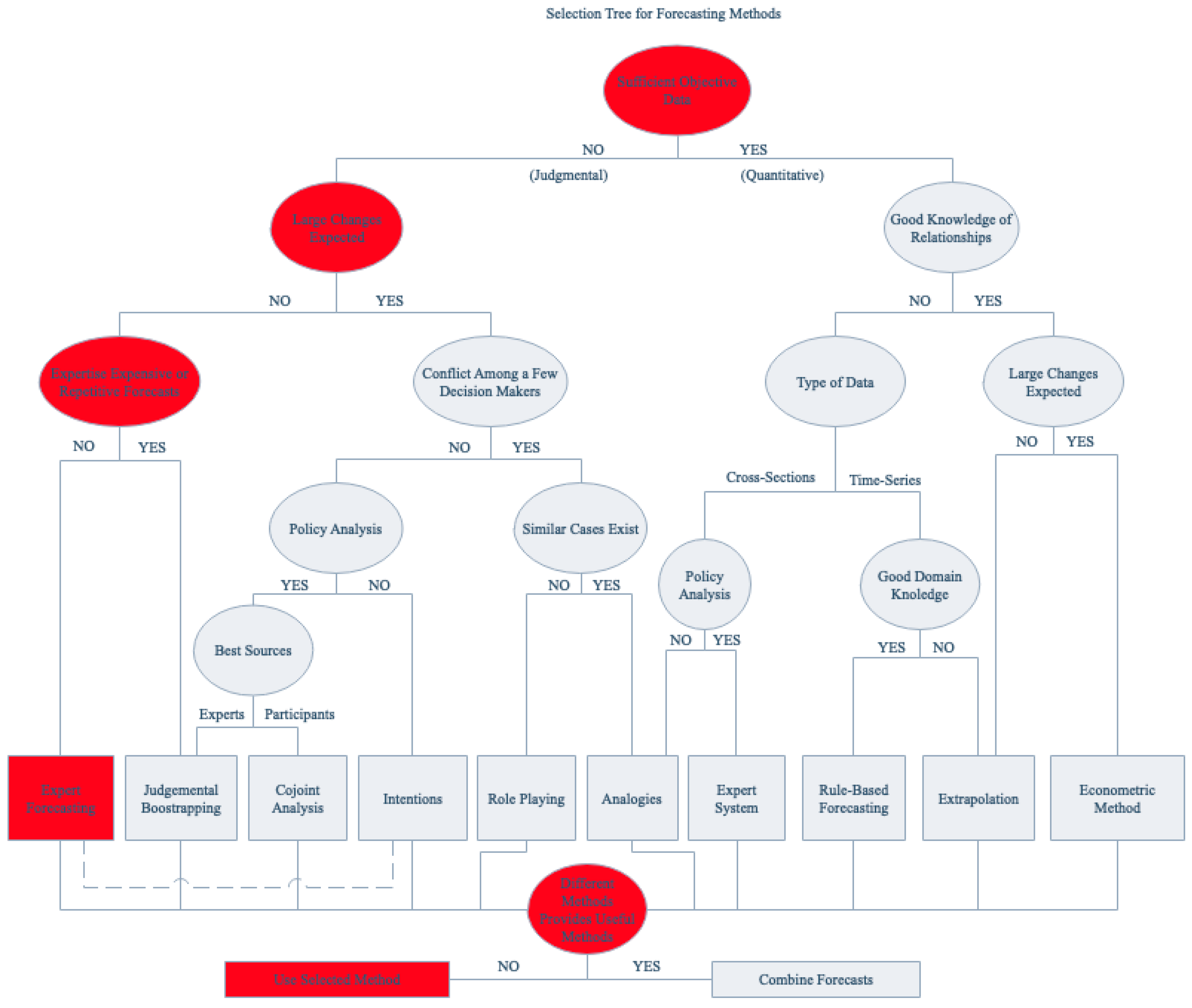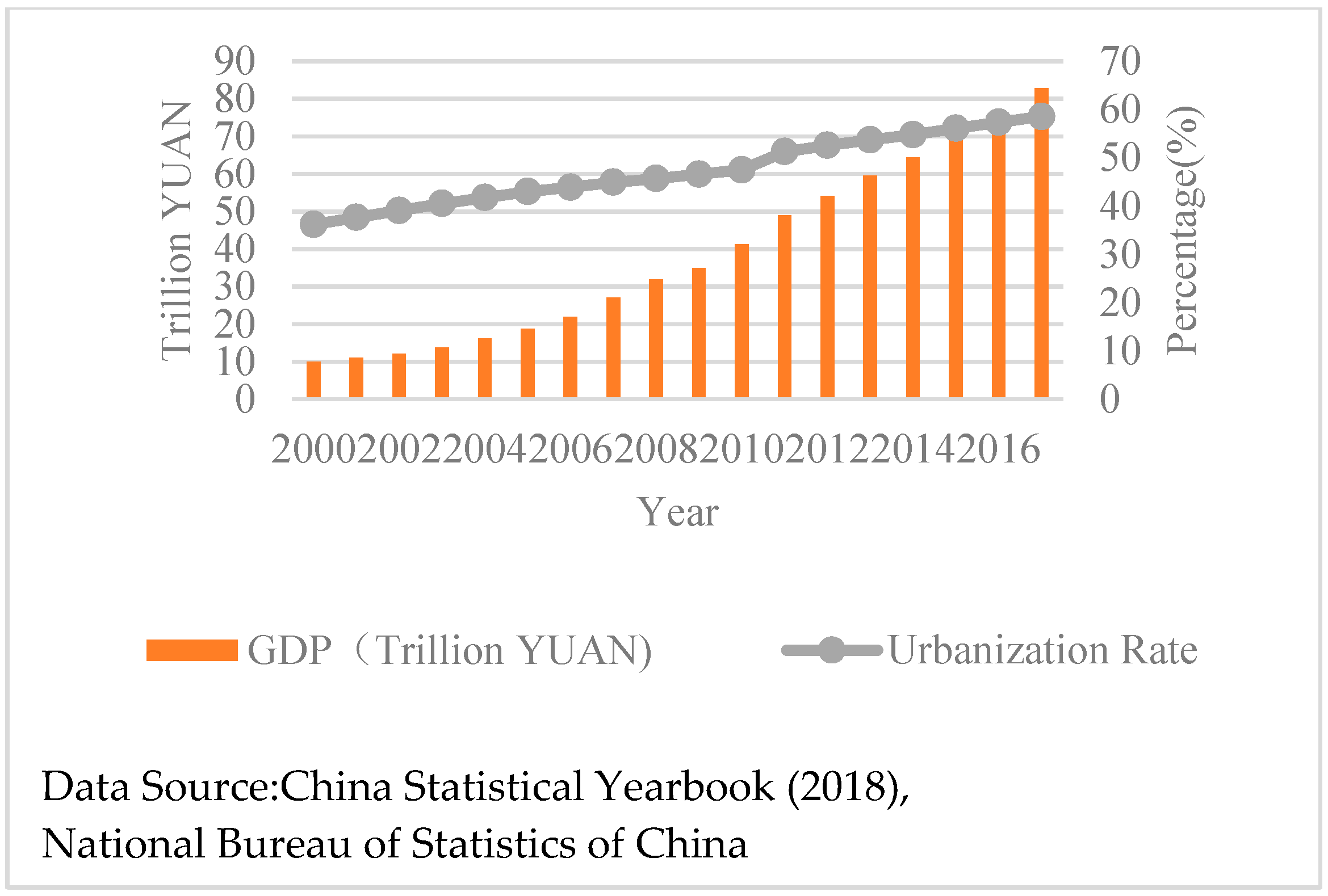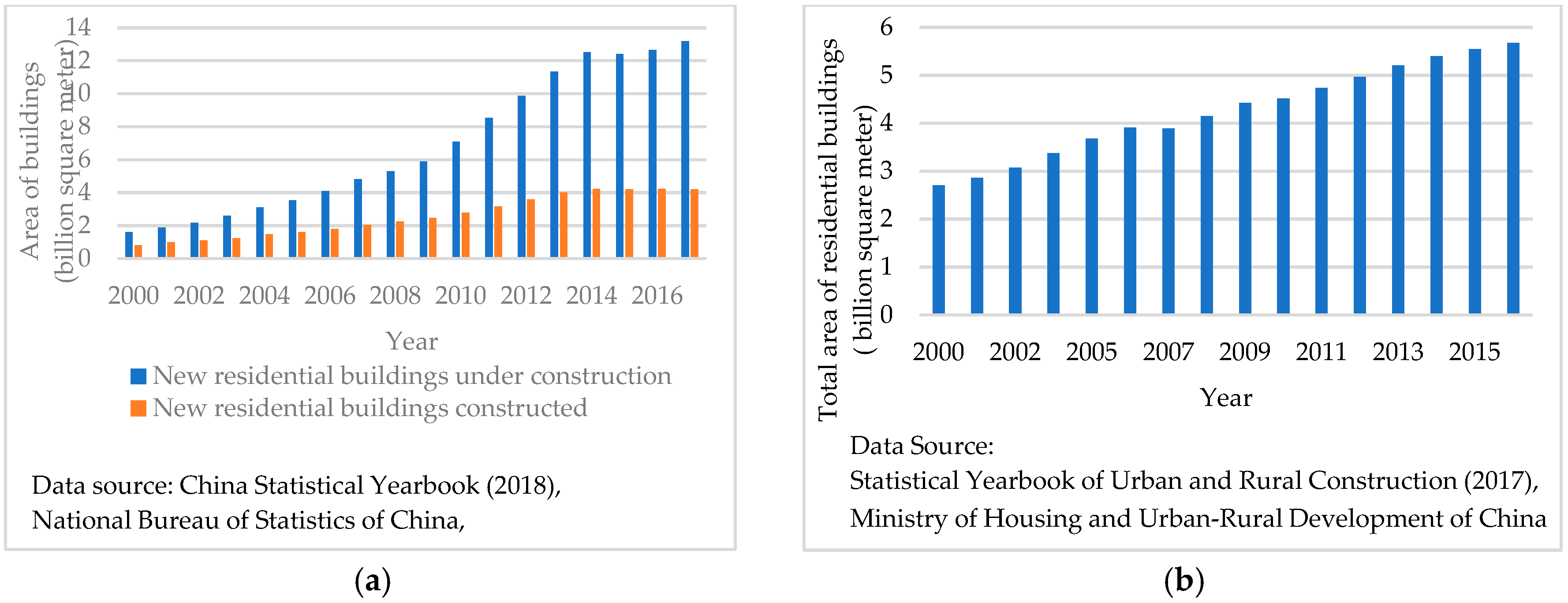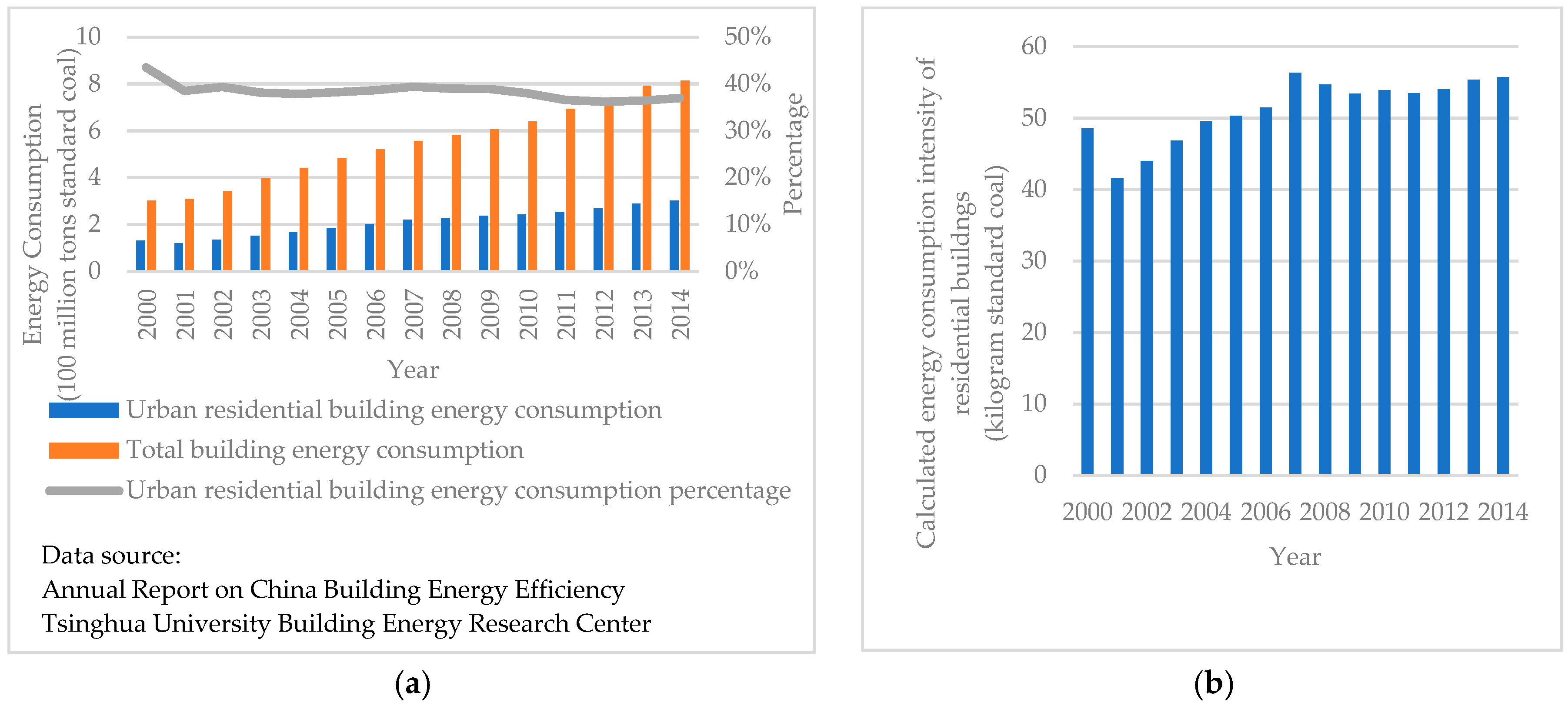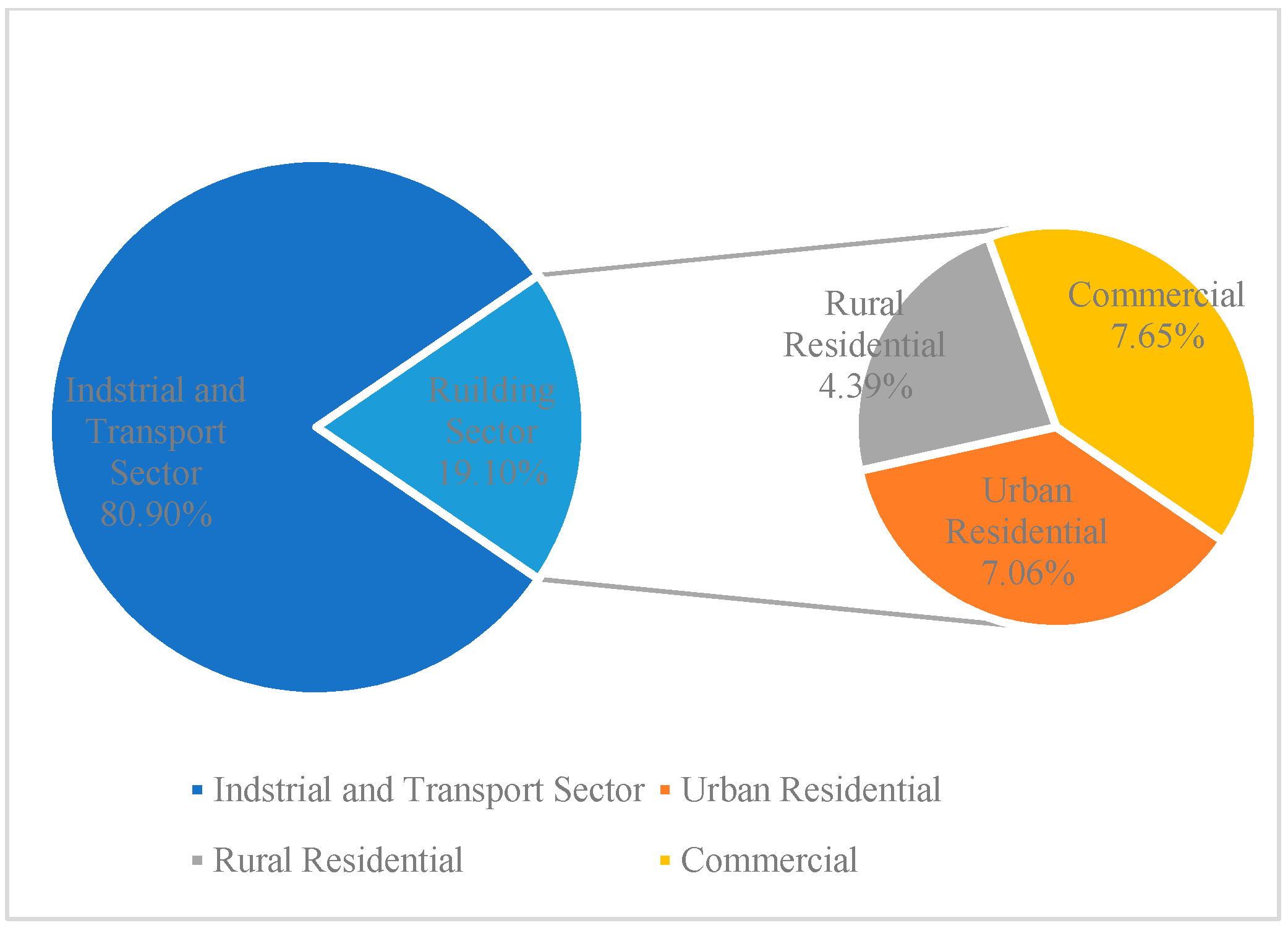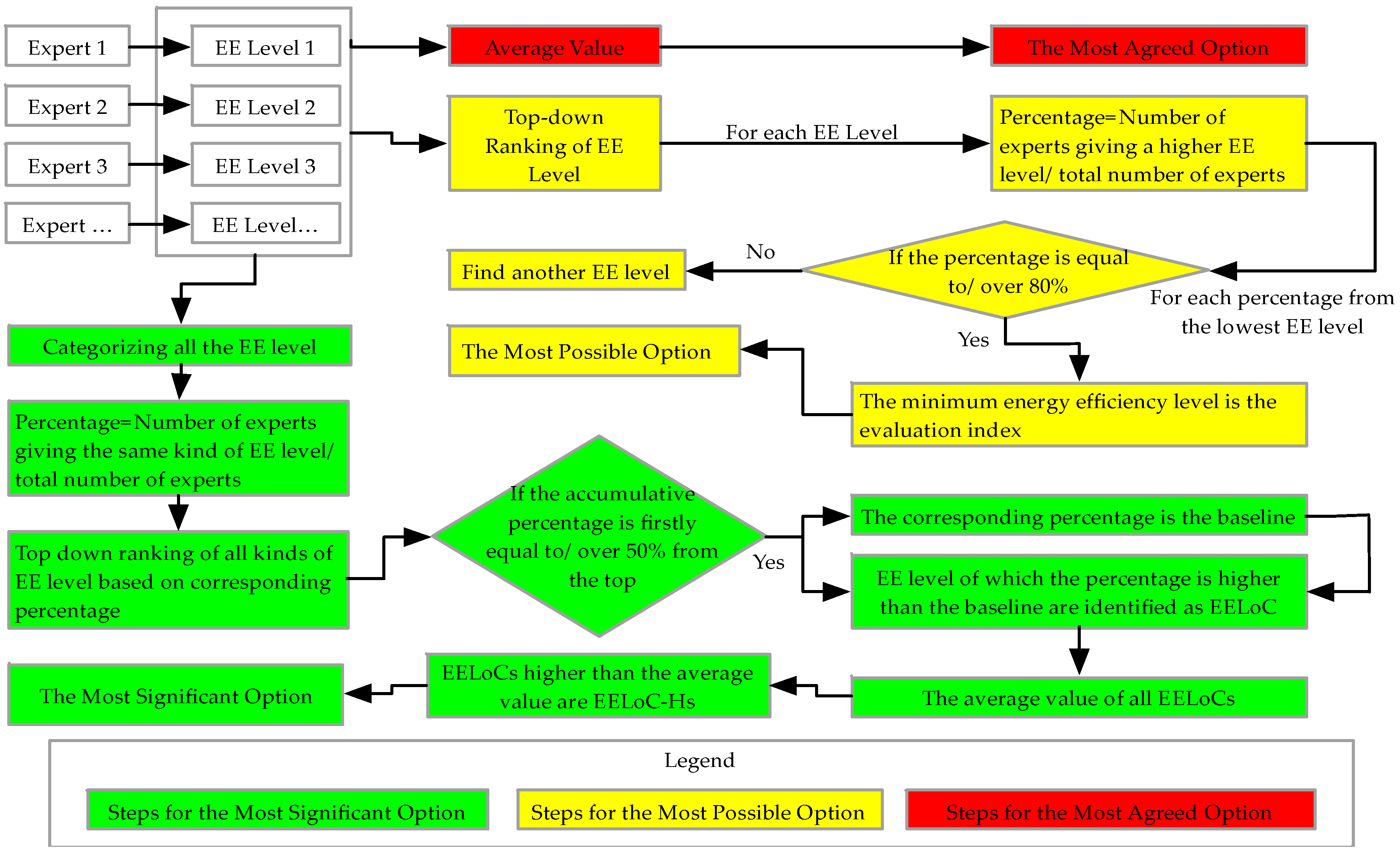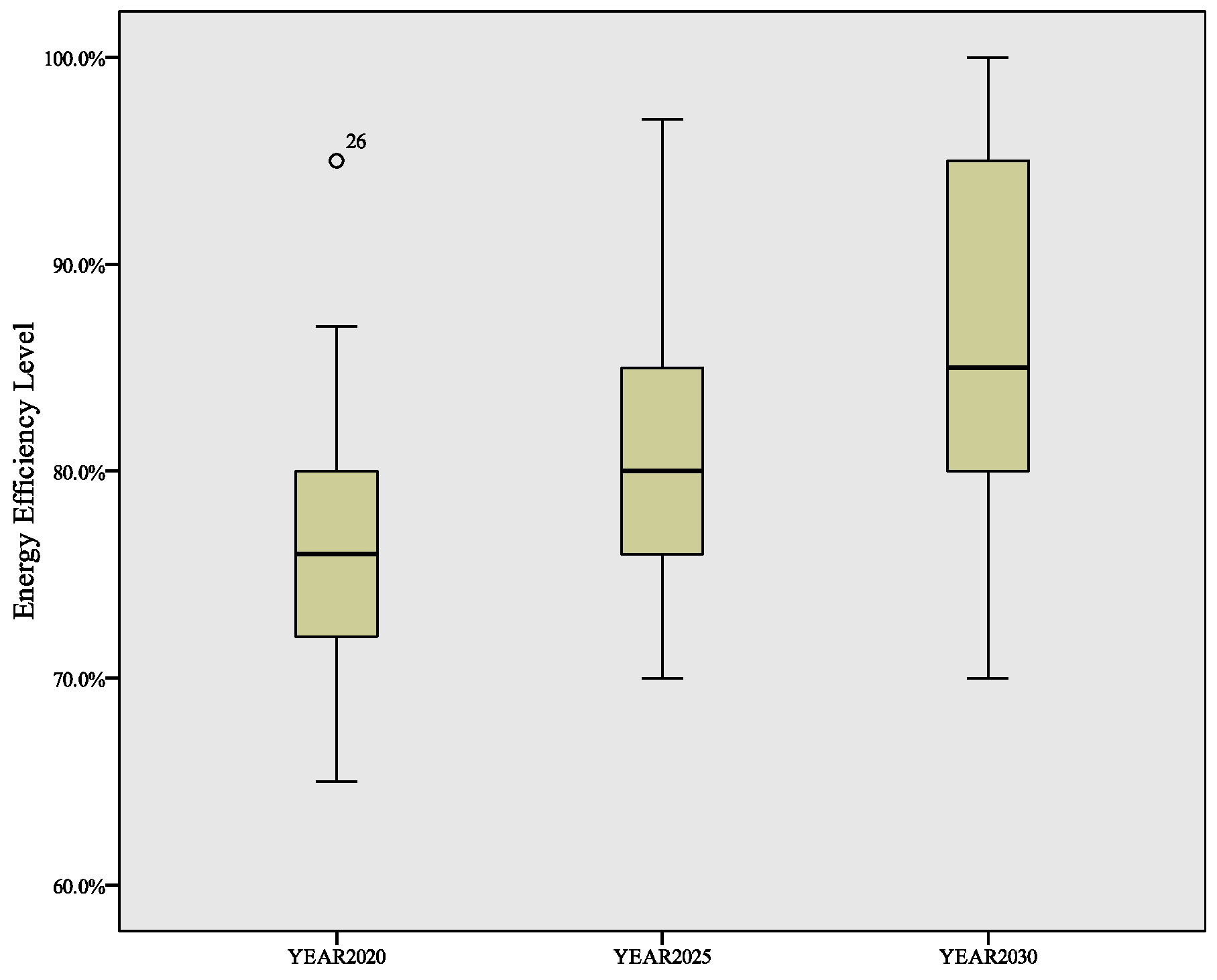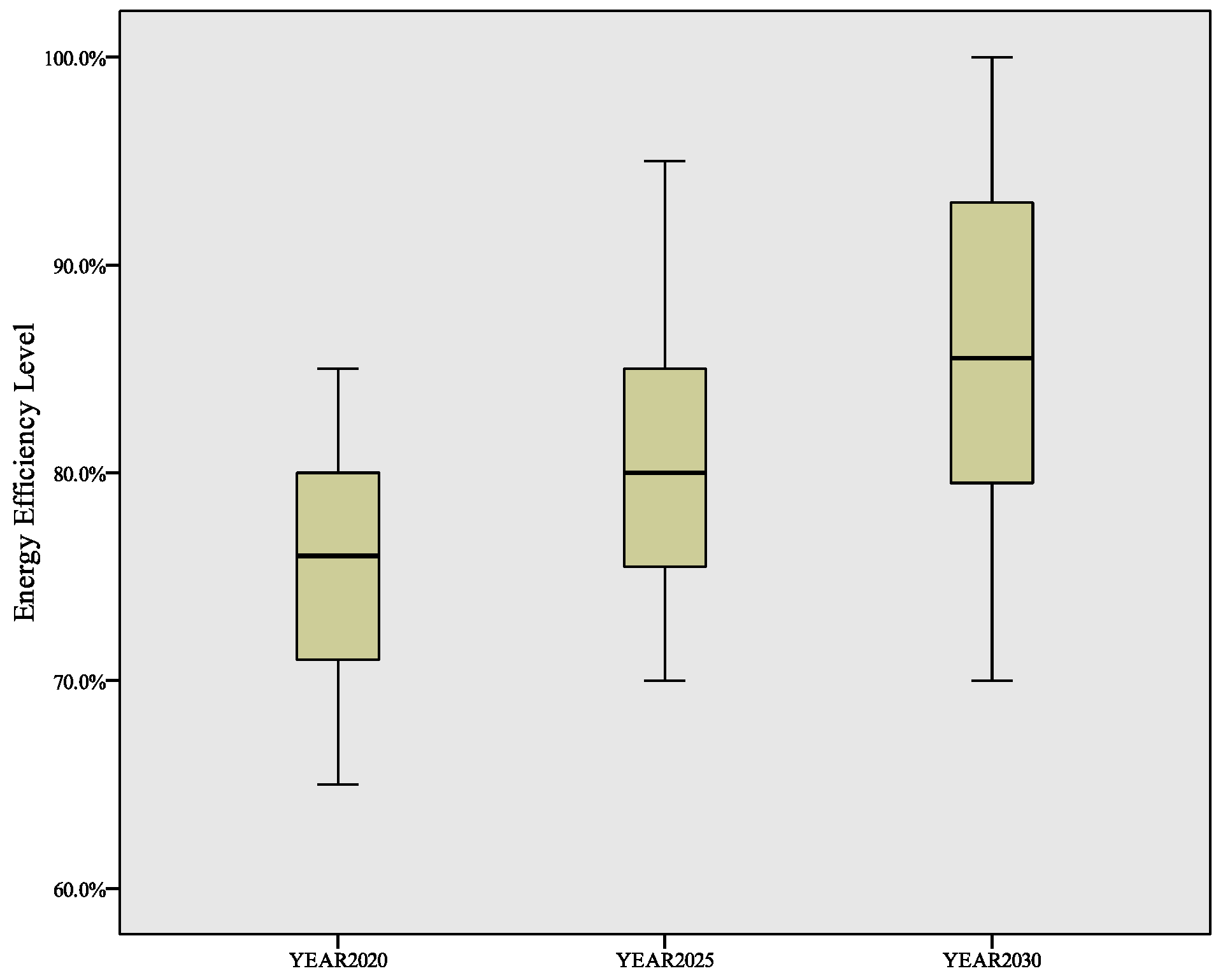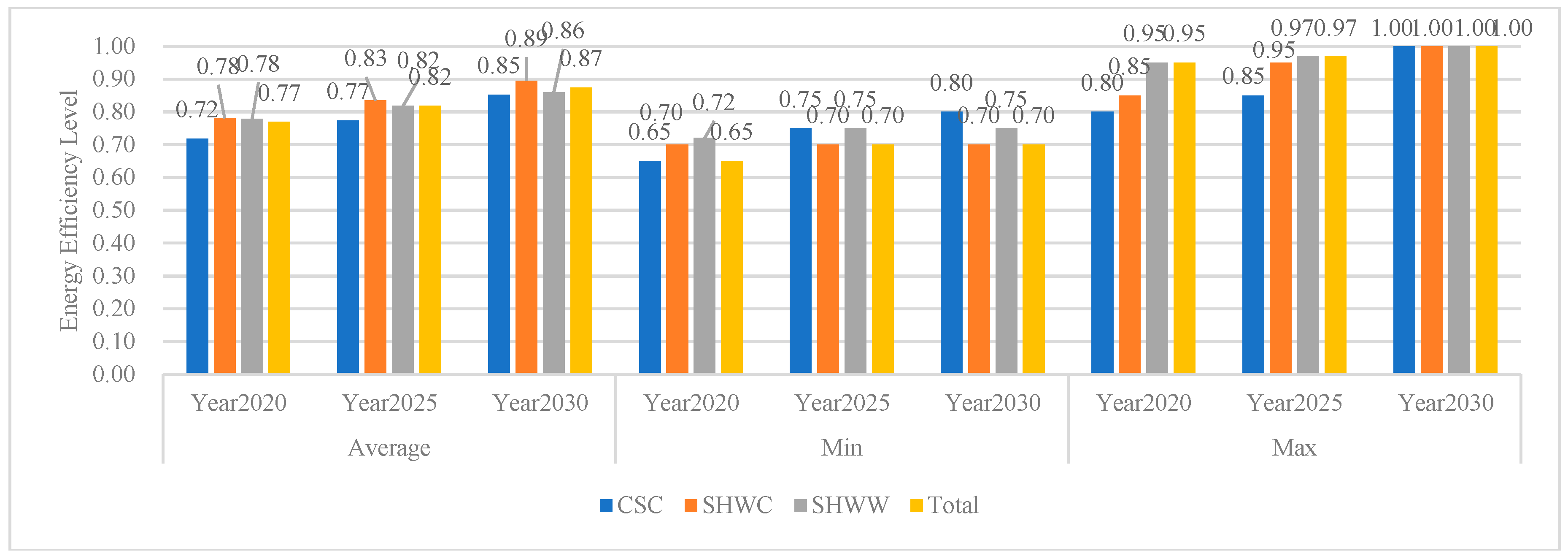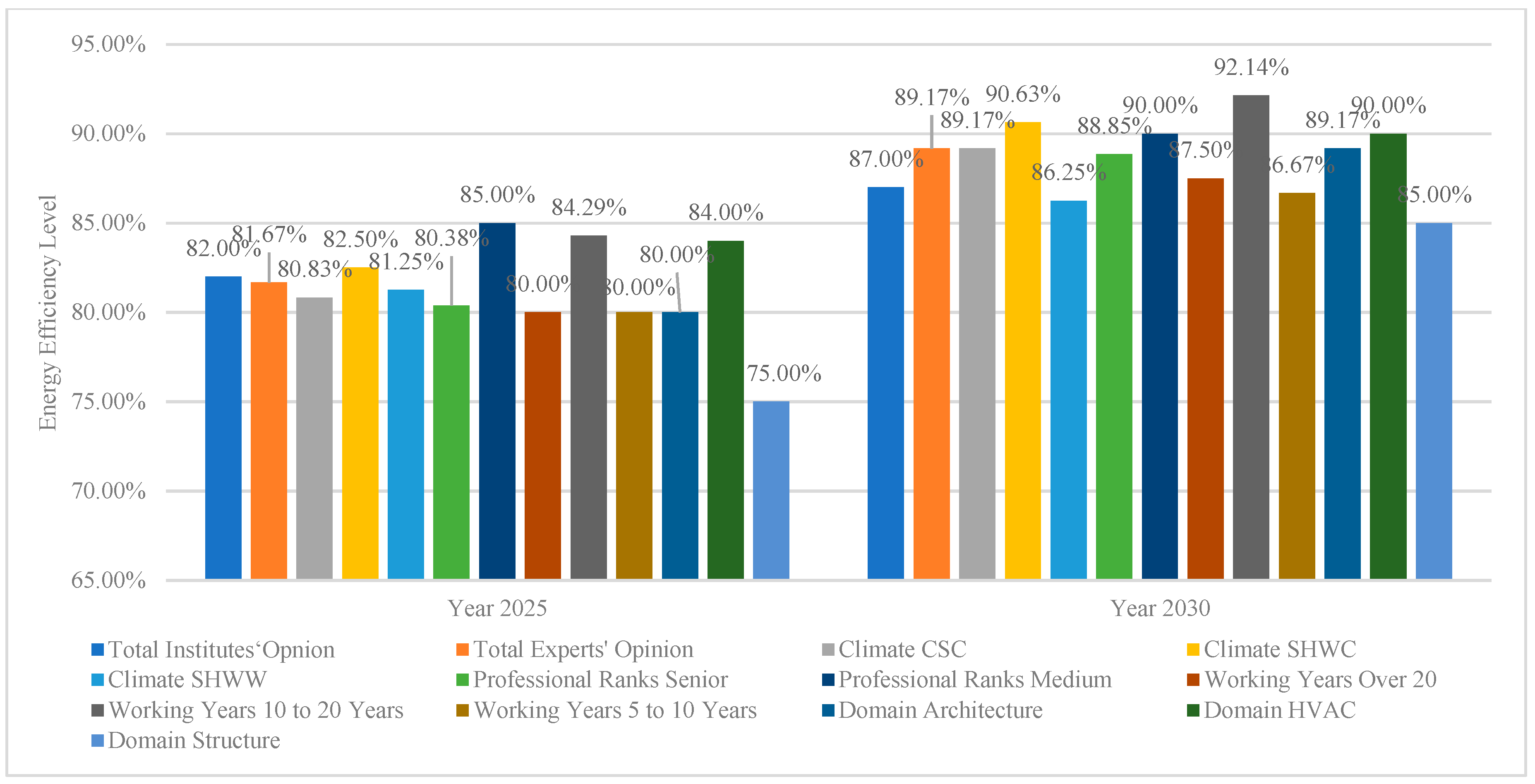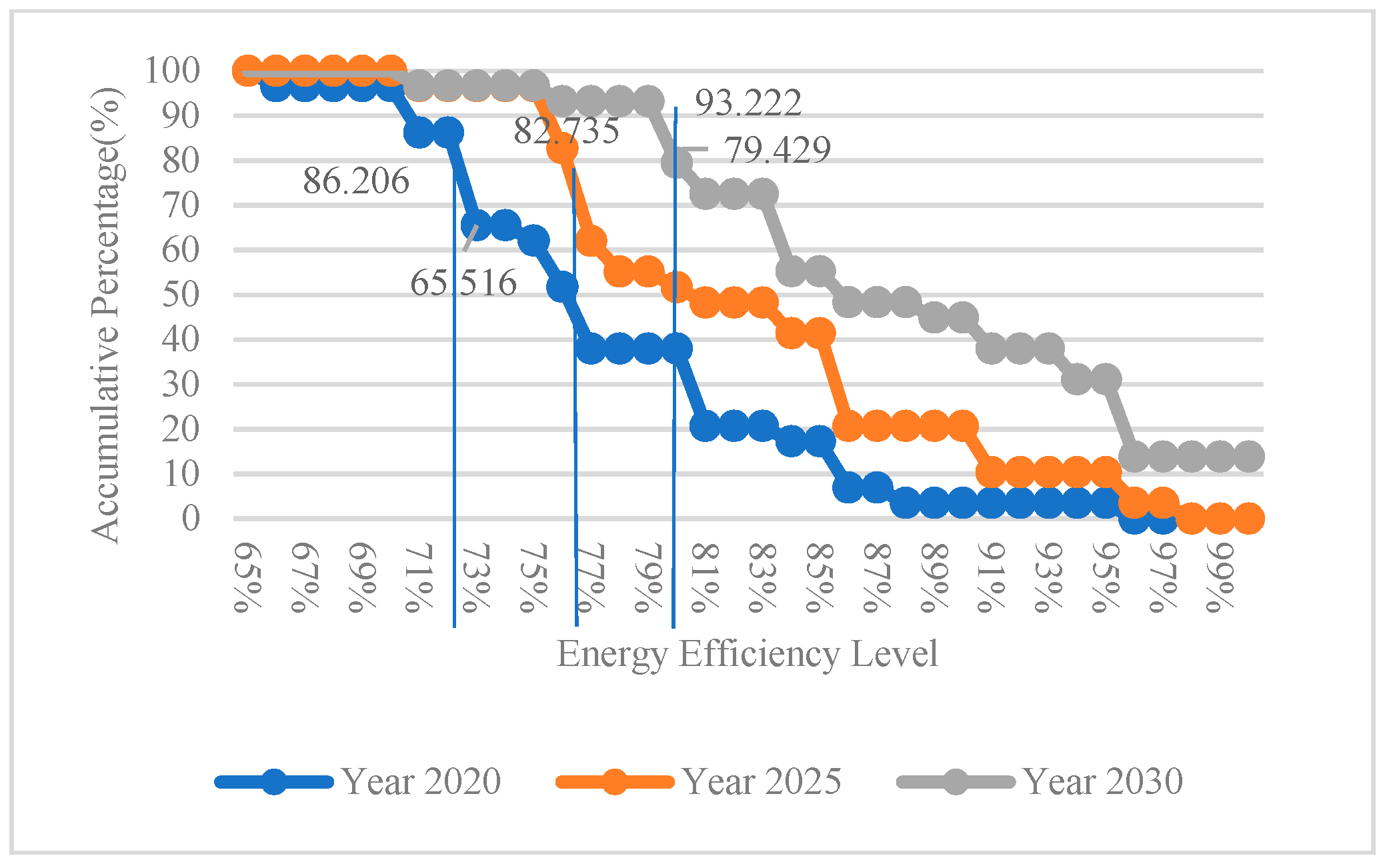4.1. Profile of Institutes’ Opinions
On average, opinions collected in the institutes’ questionnaire indicate that the EE requirement of the new residential buildings should be increased to 77%, 82%, and 87% in 2020, 2025, and 2030, respectively, which equals EE improvements of approximately 34%, 21%, and 30%, respectively, over the previous level. However, the variances of institutes’ opinions increase along with the projected length. As shown in
Figure 8, the variances in 2020 range from 72.5% to 80.0% while that in 2030 from 80% to 95%. In addition, the increases of variances also lie in the opinions both from governments and non-governmental departments as shown in
Figure 9 and
Figure 10. These increases of variances also indicate the increasing uncertainty of attitudes to forecasting the future development of new residential building EE promotion from all the institutes.
The EE requirements forecast by various stakeholders are summarized in
Figure 11. As for attitudes from different kinds of stakeholders, results indicate that the average attitudes of government departments are closest to the total average value. The overall attitudes of design institutes tend to be conservative, whereas the opinions of universities and research institutes are rather optimistic. The opinions from real estate enterprises are higher than the total average value before 2025 but are a little bit lower by 2030.
The EE requirement forecast given by different types of institutes will reflect the real situation of EE promotion of new residential buildings from the corresponding aspects, since institutes always make decisions based on their main business and their accumulated experience. The main business of universities and research institutes centers on technology innovation. The ambitious EE requirements forecast indicate the technological availability of high-performance buildings. This is also proven by “Passive House” pilot projects in Heilongjiang and Hebei provinces [
25]. However, the attitude of design institutes implies that the massive propagation of high-performance buildings is still under development. Real estate enterprises, or developers in this context, have an expectation of higher than average EE requirements. This indicates that, despite externality, the new residential building EE promotion is still an “interesting topic” for developers. Attitudes of governments are neither “too ambitious” nor “too conservative”, which can also be regarded as the results of negotiations among stakeholders. This result, to some extent, explains how the government in China works regarding the new residential building EE promotion industry. The central government normally conducts investigations and consultations to hear opinions from various stakeholders before making decisions. This process helps governments better understand the expectations of various market entities so that ambitious yet achievable targets of both EE promotion and massive propagation of high-performance buildings can be realized with more effort.
As for opinions from different climate zones (see
Figure 12), institutes from the Cold and Severe Cold (CSC) climate zone are conservative, whereas those from Summer Hot Winter Cold (SHWC) climate zone expect the highest EE requirements. It is believed that the lack of both technology and policy innovations have lowered the expectations in the CSC climate zone, while the immaturity of technology solutions and policy packages have left more chances for EE promotion of new residential buildings in the other two climate zones. On the one hand, centralized heating has covered all residential buildings in the urban area in northern China, and its energy consumption has increased the total energy consumption of residential buildings by up to 40% [
26]. A study of 1726 buildings in northern China has indicated that the heating energy consumption intensity of different buildings varies significantly, ranging from 80 to 140 kWh/ m
2. In all, 15% of the investigated buildings have either extremely high or low energy consumption [
27]. However, the heating EE remains uninvestigated [
28].
On the other hand, the Chinese central government has launched heat reform in Northern China. The heat reform aims to reduce the amount of energy wasted by end users through reform of the heating pricing system and by establishing market mechanisms to increase heat suppliers’ efforts to improve the EE of their heat supply networks, to share the retrofit costs of EE renovation, and to promote retrofitting [
29]. However, due to technical and institutional barriers, this reform has progressed slowly in most northern provinces, and the penetration rate of consumption-based pricing policy in most northern cities is still very low [
30]. Moreover, the implementation of “Passive houses” in China faces multiple technical problems regarding massive propagation [
31].
In contrast, EE promotion in the SHWC Zone and the Summer Hot Winter Warm (SHWW) Zone is gaining more attention from policymakers and engineers. For example, the optimized heating technical strategy and the corresponding policy package design in the SHWC Zone have been hot topics among policy-makers since 2012. Various concepts have been translated into pilot projects, such as “Passive house” in Anhui Province. The immaturity of the technology strategy prompts the interest of stakeholders and engineers in exploring the highest level of EE [
32,
33,
34]. In addition, central governments are paying more attentions on piloting policy settings in these two climate zones, which has further promoted the expectations of the stakeholders for the EE promotion of new residential buildings [
35].
There also might be some arguments that the development level in a district will significantly influence the expectation of building EE promotion, since provinces in the SHWC and SHWW climate zones have a higher average GDP value. However, the result of a correlation test between EE requirements and GDPs counters this argument. As indicated in
Table 2, the distribution of institutes’ opinions is not significantly correlated with the GDP distribution in 2025 and 2030. As for 2020, the Person Correlation Coefficient between GDP and EE requirement is only 0.382, which also means that these two factors are not strongly correlated.
4.2. Profile of Experts’ Opinions and Consensus
The EE requirement for 2020 was intentionally upgraded to 75%, and those of 2025 and 2030 to 90% and almost 100%, respectively, in the expert questionnaire. A total of 25 experts were invited to fill in the questionnaire, and they all responded to the research team. However, as indicated in “No. Responded” in
Table 1, only 18 experts responded with an answer. The remaining seven experts left the whole questionnaire blank, which made it difficult to tell whether they were supportive of the preset EE requirement or wished to reserve their judgments. Thus, the questionnaires that were not responded with any judgments were identified as “ineffective” and were not taken into consideration when the analysis was conducted. Among all those “effective” responses, some experts raised objections for only one time node or two. Under this circumstance, EE requirements with no responses were considered to have been approved by experts. Generally, the trend of these opinions was to decrease the proposed EE requirement, which means that the preset targets in the expert questionnaire are too ambitious and that changes should be made to achieve a more practical requirement.
Specifically, the number of objections and their constitution varies at different time nodes, as summarized in
Figure 13. Taking 60% agreement from experts as the baseline for consensus, the proposed EE requirements in 2025 and 2030 were evaluated as being not acceptable.
For the time node 2020, only six experts raised objections. Of these objectors, half proposed an EE requirement of 70%, and the other half proposed a requirement of 65% which is in accordance with the current EE requirement. However, the preset EE requirement (75%) was evaluated as acceptable, since two-thirds of the respondents agreed with this setting.
For the time node 2025, the EE requirement proposed by the research team is evaluated as “unacceptable”, since 15 experts raised objections. All the objectors proposed EE requirements that are lower than is the preset EE requirement (90%). Seven of the objectors supported an 80% EE requirement, four supported a 75% requirement, and four supported an 85% requirement.
For the time node 2030, all the respondents did not support the “around 100% EE requirement”. Meanwhile, respondents gave specific answers. These opinions range from 80% to 95% EE requirements. Most (seven) of these experts supported an EE requirement of 90%, and five of them supported an EE requirement of 95%.
The calculated variances of experts’ opinions (see
Table 3) indicate that consensus was reached among the investigated experts, regardless of perspectives. Meanwhile, the average opinions from experts were 81.67% EE in 2025 and 89.17% EE in 2030, which is quite close to the average opinion achieved in the institutional questionnaire.
To better characterize the experts’ opinions collected in the first round of the expert questionnaire, the average EE requirement was calculated, taking climate zones, professional ranks, and working years into consideration (see
Figure 14). Generally, the distribution pattern of average opinions in 2025 and 2030 are the same. The average opinions from the perspectives of climate, professional ranks, working years, and domain knowledge range from 75% to 85% EE in 2025 and from 85% to 92.14% EE in 2030. The distribution of the average opinions from the climate perspective is in line with that of the distribution of opinions collected in the institutes’ questionnaire. From the perspective of professional ranks, senior experts tend to be more conservative than medium ranked experts. The average values of EE forecast by senior experts are 4.62% and 1.15% lower in 2025 and 2030, respectively, than are those forecast by medium-ranked experts. Since most of the senior ranked experts have worked for more than twenty years, there is a great similarity between the distribution from the perspectives of both professional rank and working years. Experts who have worked for more than ten years and less than twenty years hold the most optimistic attitudes, and those who have worked either for more than twenty years or for less than ten years have similar, and significantly lower, judgments regarding the EE requirement. From the perspective of domain knowledge, more experts in HVAC than in Architecture believe that a high EE level can be reached.
Despite the diversity of average opinions from various perspectives, the consensus according to Delphi is still considered as having been achieved. The direct differences between the institutes’ questionnaire and the experts’ questionnaire range from 0.12% to 3.30%, which are within the requirements for consensus (5% difference), according to the principles set in
Section 3.3. Considering the minor level of difference, the average value of the EE requirement at each time node is used to represent the consensus. The results are listed in
Table 4, and the approximation for policy implication is marked as “Average Approximation”. This combination is also identified as the “
Most Agreed Option”, according to
Section 3.3. Correspondingly, it can be concluded that, as agreed by the institutes and experts investigated, the EE requirement in the new residential sector should be promoted to 75% nationwide by 2020, 82% by 2025, and 88% by 2030.
4.3. The “Most Possible Option” and the “Most Significant Options”
The calculation of the “Most Possible Option” was based on the accumulative percentage of institutes’ and experts’ judgment in a descending order. As the result in
Figure 15 indicates, 86.206% of institutes believe that an EE requirement of 72% could be set for 2020. A total of 82.725% of institutes believed that the EE requirement could be further promoted to 76% by 2025, and 93.22% experts held the opinion that the EE requirement should reach 79% by 2030. According to the distribution of experts’ opinions in
Figure 16, the identified EE requirements were 70%, 75%, and 85% respectively, which was quite similar to the conclusion drawn from the institutes’ questionnaire.
Despite the minor difference of the EE value in 2020 (72% and 70%) and 2025 (76% and 75%), the great difference in 2030 (79% and 85%) indicated that consensus could not be considered as having been achieved. Therefore, one more round of the questionnaire was conducted. For the third round of the questionnaire, the proposed EE requirements were based on the average opinions from the institutes’ and experts’ questionnaires. To form a stepwise EE promotion roadmap, we improved the EE requirement for 2020 slightly, to 72% and the EE requirement for 2025 slightly, to 78%, so that the EE improvement between each time node was kept as 20%. The Likert 5-Scale was introduced to measure the “achievability” of the proposed EE requirement. The correspondence between the Likert scoring and the actual meaning was indicated in
Figure 17.
The result of experts’ scorings, the average values of which exceeded three, indicated that the proposed EE requirements at all time nodes were achievable. Consequently, the proposed EE requirement at each time node was identified as the “Most Possible Option”.
Table 5 summarized the results of Likert scoring from experts by indicating the average values. The average values indicated that all the proposed EE requirements were achievable according to
Figure 17. Correspondingly, the proposed EE requirements at Year 2020, 2025 and 2030 were identified as the “Most Possible Option”. In addition, it is noteworthy that the average scoring values of the EE requirements in Year 2020 and Year 2025 were quite similar, while there was an obvious decrease occurred at the scoring of the EE requirement in the Year 2030. The former two average values indicated that the EE requirements in 2020 and 2025 were relatively easy to achieve from experts while the last one was only evaluated as achievable. Along with the decrease of average value, the variance of scorings from experts are rising according to the projected length. The increase was also in accordance with the phenomenon found in the institutional questionnaire — that the certainty of forecasting is decreasing with the projected length increasing. Comparatively, the agreement achieved on the target setting of the year 2020 could be considered as unusually strong and the agreement on that of the year 2025 could be considered as strong, whilst the agreement on the year 2030 was not as strong as the previous two.
As for exploring the “
Most Significant Option”, probability distributions were calculated at each time node to identify possible combinations of different opinions from institutions. There were 3, 3, and 4
EELoCs in 2020, 2025, and 2030, respectively. Two
EELoC-Hs were identified at each time node. Therefore, 14 combinations of these
EELoCs were found as summarized in
Table 6, according to the principles described in
Section 3. Four of them (No. 6, No. 7, No. 9, and No. 13) have been identified as the “Most Significant Option” since they possess
EELoC-H at all the time nodes, and they were marked as
bold in
Table 6.
Among these four options, two EE levels were found at each time node. With respect to the raw data of the institutes’ questionnaire, those who believed that the EE requirement should be 72% by 2020 also tended to believe that the EE requirement should be 76% by 2025 and 83% by 2030 or vice versa. Those who believed that the EE requirement should be 76% by 2025 held the opinion that an EE requirement of 72% is best for 2020. Those who believed that an EE requirement of 85% should be reached by 2030 argued that an EE requirement of 80% was best for 2020. However, dispersion of opinion appeared when it came to an EE requirement of 95% by 2030. Experts did not hold the same opinion regarding determining the EE requirements in 2025 and 2030. This further indicated that the Option No.3 and No.6 didnot exist in the responses from the institutes yet the Option No.4 and No.5 were made up through data processing methods. Correspondingly, options No.3 and No.6 were considered more convincing than are the other two options.
The “Most Significant Options” indicated in the institutes’ and experts’ questionnaires clearly indicated the negotiation process that happened in the Delphi process (see
Table 7). In the institutes’ questionnaire, four “Most Significant Options” were identified. As for the experts’ questionnaire, only one “Most Significant Option” was identified. Coincidentally, the most significant opinion of experts was the average opinion of option No.3 and No.6 in the institutes’ questionnaire, despite the minor variance. It was believed by the author that the change of the “Most Significant Option” between these two rounds of questionnaires was also evidence of the negotiation among experts and institutions. Experts supporting Option 3 and Option 6 negotiated in the Delphi process and finally revised their judgements so that consensus over the “Most Significant Option” can be achieved.
4.4. Discussions about the Selection of and Adjustments to the Delphi
The Delphi method was first developed by the RAND Company in the 1940s and was initially applied in the military field [
36]. After decryption, it became one of the most well-known and widely used forecasting methods by US companies in the field of industry and public service development forecasting in the 1960s. The method then spread to Europe and Asia, and finally became popular worldwide. The effectiveness of the Delphi method has already been proved by numerous studies in various fields.
The Delphi method can be classified into three categories: the Traditional Delphi method (also known as “
Classical Delphi”), the Decision-making Delphi method, and the Policy Delphi method [
20]. Whereas the Traditional Delphi method and the Decision-making Delphi method are designed for collecting opinions from experts to form a consensus, the Policy Delphi method is designed for exploring the possibilities of policy settings and solutions by as much as is possible [
37,
38]. Meanwhile, the Traditional Delphi method and the Policy Delphi method are designed for collecting advice from experts, whereas the Decision-making Delphi method is used to collect advice from the real decision makers to build the future, rather than describing or forecasting it [
39]. In brief, A “Policy” Delphi is used when there is a need to devise a strategy to address a specific problem, a “Classical” Delphi is used to establish consensus and forecast the future, and a “Decision-Making” Delphi is used to achieve better decision-making.
The reason why the Traditional Delphi method was selected depends not only on its effectiveness in collecting experts’ opinions and seeking consensus but also on its nature regarding forecasting, which is also in accordance with the essence of this research. In the context of forecasting, many forecasting methods can be used in this paper. These methods are generally separated into three categories: Qualitative Methods, Time Series & Projection methods, and Causal Methods. These forecasting methods provide forecasters with abundant choices in response to various conditions when forecasting. According to Armstrong, the selection of these forecasting methods should follow the proposed selection tree based on the following six principles: Convenience, Market popularity, Structured judgment, Statistical criteria, Relative track records and Guidelines from prior research. To examine these more critically, Convenience, “what is easy,” is inexpensive but risky; Market popularity, “what others do,” sounds appealing but is unlikely to be of value because popularity and success may not be related and because it overlooks some methods; Structured judgment, “what experts advise,” which involves rating methods against prespecified criteria, is promising; Statistical criteria, “what should work,” are widely used and valuable, but they are risky if applied narrowly; and Relative track records, “what has worked in this situation,” are expensive because they depend on conducting evaluation studies [
21]. Specifically, in this paper, the Delphi was selected since the existing objective data are not sufficient for rational quantitative forecasting, no large changes are expected, and expert questionnaires are relatively cost-effective. The corresponding process is summarized in
Appendix A Figure A1. In addition, the Delphi Process is also preferred due to its superiority in terms of cost, accuracy, turning-point identification, and accuracy [
40,
41].
Despite numerous advantages proved by previous studies, the Delphi method also has natural deficiencies, as summarized in
Appendix A Table A4 [
24]. In brief, the result and the effectiveness of the Delphi method are affected significantly by the perceptions of the experts’ participating in the Delphi process and the investigator’s design of the details of implementation. These deficiencies are eliminated by both a better design of the Delphi process and modifications to the methodology. Systematic sampling of experienced frontline experts and a structured questionnaire design were introduced due to Delphi’s sensitivity to design and management characteristics (see No. 1 and No. 2 in
Table 8). Disadvantages related to the experts’ participation and judgments (see Nos. 3, 4, 5, and 6 in
Table 8) were eliminated by conducting a kick-off meeting. The principles of participation in Delphi—as well as incentives—as approved by all the experts, were introduced. Delphi experts were required to make judgements independently and with careful consideration of their response. As for the convergence speed, many case studies have proven that, if there are significant differences of opinion among the expert panel, it might not be possible for the experts to reach consensus in limited rounds of surveys [
42,
43].
In response, this paper modified the first round of the Delphi questionnaire to create an institutional questionnaire so that: (1) as many kinds of opinions as possible could be explored, and (2) the following Delphi could test the robustness of all the identified results of the institutes’ questionnaire. It is believed by author that the consensus among experts could be more easily to be achieved by providing less flexibility to investigated experts in giving judgments.
Despite that the Delphi is an effective method for reaching consensus and forecasting the future, it is a method based on psychological and sociological judgments. Although the industry of promoting building EE is a complex socio-technical sector, it is not so convincing if some conclusions relevant to technologies are made without specific technological analysis. A workshop was held after the implementation of the Delphi process, with the aim of checking the feasibility of the results from a technological perspective. The calculation process is summarized in
Section 3.3.
4.5. Discussions about the Investigation Outcomes
Via Delphi methods, this paper conducted one round of a nationwide institutes’ questionnaire and two rounds of an experts’ questionnaire to seek consensus and diversity of possibilities among experts regarding target setting of EE promotion of new residential buildings in China. After data processing, the “Most Agreed Option,” the “Most Significant Option,” and the “Most Possible Option” were identified, as listed in
Table 9. The “Most Agreed Option,” determined on the basis of the average opinions, is similar to the “Most Significant Option” which is based on descriptive statistics. The “Most Possible Option,” which is agreed by over 80% institutes and experts at each time node, is rather conservative. This option proposes a roadmap in which EE promotion is approximately five years’ behind the other two options. Meanwhile, the average improvements between time nodes are also smaller.
It should also be noticed that the EE improvements in 2025, especially in the “Most Agreed Option” and the “Most Significant Option”, tend to be conservative but rather ambitious by 2030. Considering it took China twelve years to upgrade its national EE requirement by 30%, it seems irrational to realize an EE improvement of the same level in only five years. However, the verification workshop held after the whole Delphi Process presented the explanations by the experts involved in the questionnaire. Currently, China has adopted a percentage system as the index illustrating building EE requirements in the new residential sector. The comparison of the original energy efficiency percentage system and the energy intensity system is summarized in
Table 10. This energy efficiency percentage system magnifies the effect of each equal improvement of intensity with the increase in EE requirement. For example, 5 kWh/m
2a represents a 10.00% difference in improvement of EE at the 64% level that rises to 33.33% at the 82% level. Under the current system, the 30% improvement of building EE will be increasingly easy to achieve, since it equals increasingly less reduction of energy intensity. Correspondingly, the experts suggested that the current system of evaluating new residential building EE should be substituted by the new system based on energy intensity.
Along with the evaluation system, experts also came to a consensus on the final goal of new residential building EE promotion by 2030, as suggested in the “Most Agreed Option” and the “Most Significant Option”. They believed that the EE level should reach the EE requirement of “Passive House” [
44]. In the 1980s, the density of energy consumption for heating in northern China (CSC climate zone) was approximately 0.45 GJ/m
2a, on average, in the design phase (excluding heat loss from pipe systems). Based on the energy conversion equation, it can be calculated that the energy consumption density in the 1980s was 125 kWh/m
2a. By 2030, the energy intensity of new residential buildings should, and can be reduced to lower than 15 kWh/m
2a, according the “Most Agreed Option” and the “Most Significant Option.”
In comparison with many of the proposed new residential building EE promotion targets set by some of the world’s leading countries (see
Table 11), either the “Most Agreed Option” or the “Most Significant Option” seems conservative. The European Union has published a formal definition of Nearly Zero Energy Building in 2010, which refers to a “nearly zero energy building” as a building that has very high energy performance. The nearly zero or very low amount of energy required should be covered to a very significant extent by energy from renewable sources, including energy from renewable sources produced either on-site or nearby [
45]. Under the framework of Directive 2010/31/EU on the recast of the Energy Performance of Buildings Directive (EPBD), European countries promised to realize the EE requirements proposed in the EPBD by 2020. The “Passive House” concept, developed in Germany, is one of the best technology practices. China, as agreed by the experts investigated, will realize this target nationwide by 2030. Exceptions can also be found in the US and Japan, who also promised to achieve the goal of Net-Zero Energy Building by 2030. The EE promotion targets proposed for China in this paper are more ambitious, since the 2030 goal in America is aimed only at new federal buildings, whereas the Chinese goal is for all new residential buildings.
As stated previously in
Section 2, the three identified target setting options provide a clear pathway for policy making. Future mandatory design standards for new residential building EE promotion can adopt these target settings and translate them into more detailed requirements for the key parameters affecting the performance of buildings. In accordance with one specific target setting option, government departments can develop a series of long-term policies, thus improving the confidence of and realizing the expectations from various stakeholders. Market participants in new residential building EE promotion sector can also plan and adjust their strategies for the future development.
However, it shall be also noted that a proper development of long-term policy package should take stakeholders’ opinions into consideration. In this paper, although the Delphi method has provided adequate information about target setting by investigating into frontline stakeholders, the corresponding reason and consideration why the respondents make such judgements are concealed and omitted. For future studies, it is considered by the author that, the foundation for corresponding policy package development - what the stakeholders think regarding the implementation of the targets, or in other words, why they give such forecasts towards future EE promotion, shall be investigated and analyzed.
